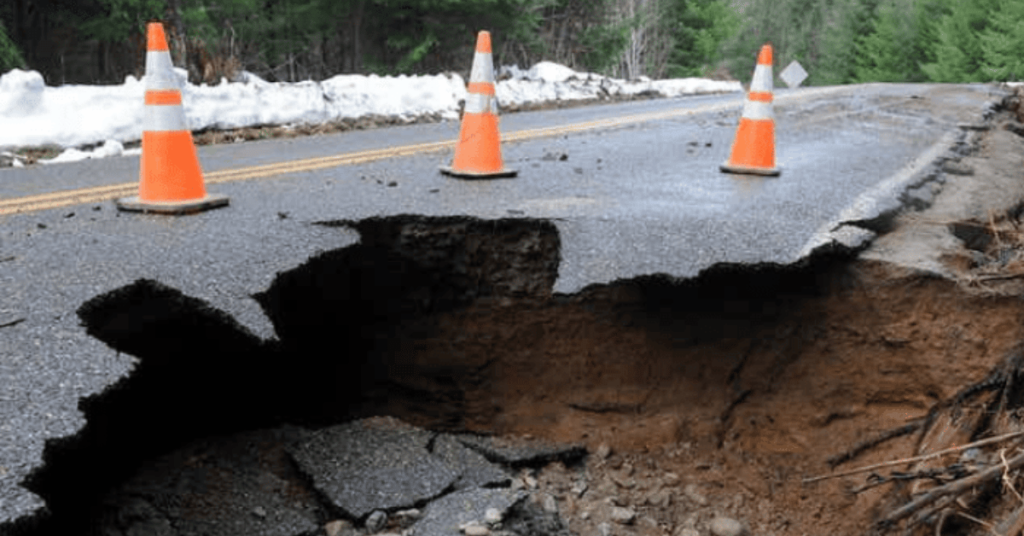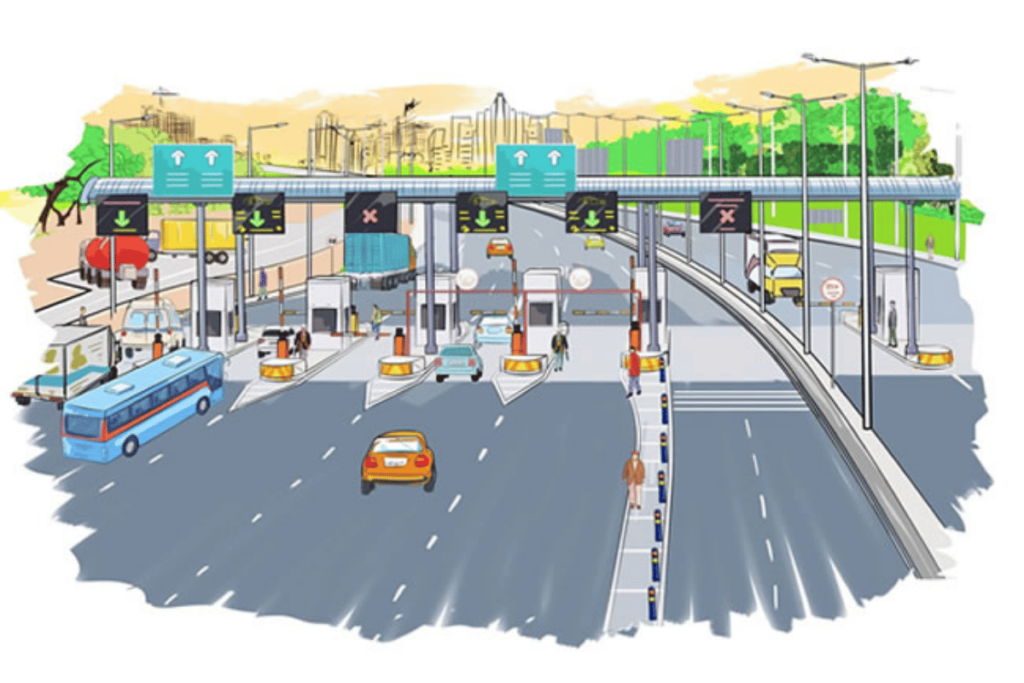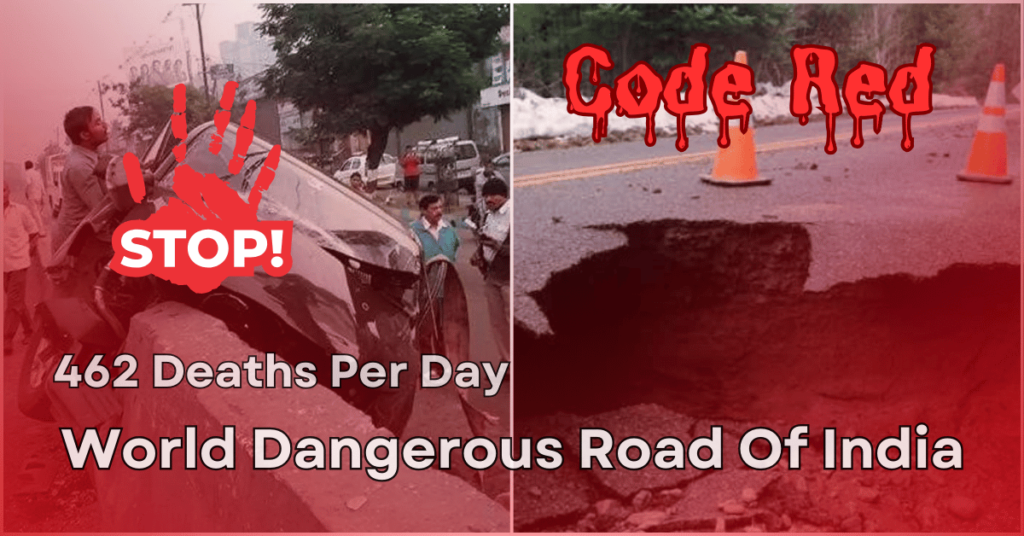India’s roads are crowded with vehicles and pedestrians. Because of this, there are many road accidents. In 2021 alone, more than 150,000 people died in road accidents in the country. This means about 415 deaths per day. This worrying statistic, reported by the Ministry of Road Transport and Highways (MoRTH) in their 2021 report on road accidents in India, shows how much work still needs to be done on road safety in the country.
These accidents not only result in loss of life but also cause immense suffering to the families involved. They put a lot of pressure on healthcare systems and become an economic burden on the country. According to the World Bank, road accidents cost India 3% of its GDP every year.
In this article, we will discuss the factors that lead to road accidents in India. We will also look into the shortcomings in road safety, issues related to vehicles, driver behavior, and enforcement challenges that create dangerous conditions on Indian roads. Additionally, we will examine efforts to reduce these risks through improvements in government policies, technological interventions, and awareness campaigns. Ultimately, the goal of this investigation is to highlight the path towards safer roads in India, ensuring the protection of lives and the development of a safer transportation system.
Major Challenges to Road Safety in India
In India, road accidents are part of several complex reasons. They create a dangerous environment for every citizen using the roads. These challenges can be categorized into different types. For example: lack of basic infrastructure, vehicle-related issues, problems with driver behavior and management, and various other factors, which we’ll discuss further.
Infrastructure Deficiencies

In India, a significant barrier to road safety is its inadequate road infrastructure. According to the National Crime Records Bureau (NCRB) report for 2021, about 36% of road accidents were attributed to road defects like potholes and speed bumps. Poor road design, insufficient planning for pedestrian walkways, and especially inadequate lighting in rural areas further increase this risk. The lack of proper signs and road markings often leads to confusion and accidents.
Vehicle-Related Issues
The condition and types of vehicles on Indian roads are crucial factors in road accidents. Commercial vehicles, especially trucks with heavy loads, affect their braking capacity and stability, increasing the risk of accidents. Additionally, many older vehicles lack fundamental safety features like airbags and Anti-lock Braking Systems (ABS), reducing passengers’ chances of surviving accidents. The rapidly increasing number of two-wheeled vehicles in the country poses a significant safety concern, adding another dimension to road safety issues.
Driver Behavior and Enforcement
In India, human error, often due to reckless driving, excessive speed, alcohol consumption, or disregarding traffic rules, is a major cause of road accidents. A study by SaveLIFE Foundation found that 80% of road accidents in India occur due to human error, highlighting a lack of awareness about traffic rules and poor compliance worsening the problem. Enforcement agencies often face challenges such as understaffing and difficulties in effectively enforcing traffic laws due to corruption and inadequate resources.
Other Factors
In India, several factors contribute to the road safety crisis. For instance, there’s often no provision for road safety for pedestrians and cyclists. In many countries, separate lanes are dedicated to cyclists, which is crucial in India too. Many Indian roads still lack footpaths for pedestrians, leading to increased risks of accidents. Moreover, adverse weather conditions like fog, heavy rain, and clouds can severely reduce visibility and increase the danger of accidents caused by wandering animals on the roads.
To tackle these multifaceted challenges, there’s a need for a comprehensive and unified approach that includes improving basic infrastructure, toughening vehicle safety standards, refining traffic regulations enforcement, and launching extensive awareness campaigns. In the following sections, we will explore in detail the government initiatives and potential technical solutions to make roads safer in India.
Government Initiatives and Policies
Recognizing the urgent need to address the growing road safety crisis, the Indian government has launched several initiatives and implemented policy reforms aimed at preventing accidents and fatalities. These efforts include legislative changes, national programs, and awareness campaigns designed to create a safe road environment for all.
Motor Vehicles (Amendment) Act 2019
Taking a significant step in the field of road safety, the Motor Vehicles (Amendment) Act was implemented in 2019, which brought significant changes to traffic rules and penalties. Under this act, stricter penalties were provided for traffic violations such as speeding, drunk driving, and driving without a license. Along with this, the use of helmets, seatbelts, and safety equipment for children was made mandatory, thereby promoting a culture of safety among road users. While the effectiveness of these increased penalties is still debated, this act has certainly made the issue of road safety more important.
Brasilia Declaration on Road Safety
India is a signatory to the Brasilia Declaration, a global commitment to halve road accident deaths and injuries by 2030. In line with this declaration, the Government of India has formulated the National Road Safety Policy, which lays out a comprehensive framework for improving road safety.
The policy emphasises the need for safer roads, safer vehicles, safer road users and better post-crash response. In addition, it also underlines the importance of data-based decision making and coordination between various agencies to achieve road safety goals.
Other Initiatives
The government has taken several initiatives to promote road safety. The Good Samaritan Law, implemented in 2016, provides legal protection to bystanders who help accident victims, encouraging people to help without fear of harassment. The National Road Safety Week, observed every January, aims to raise awareness about road safety through various campaigns and activities. Additionally, the government has introduced road safety education programs in schools and colleges to promote safe behavior from a young age.
To further improve road safety, the government could expand the Good Samaritan Law by explaining its protections and importance in more detail. This would encourage more people to help accident victims without fear of legal repercussions. The National Road Safety Week could be made more effective by highlighting specific programs and campaigns, such as awareness rallies, poster competitions, and street plays. The government could also emphasize the importance of road safety education for young people by providing more details about the programs being implemented in schools and colleges. These programs could teach children and young adults about traffic rules, the importance of safe driving, and pedestrian safety.
Technological Solutions for Improved Road Safety
With the continuous growth of new industries, many new and effective solutions are emerging in India to work with government initiatives and bring about revolutionary changes in road safety. These solutions range from intelligent transportation systems to advanced driver assistance systems and mobile applications, all aimed at reducing accidents, improving traffic flow, and enhancing the overall safety of road users.
Intelligent Transportation Systems (ITS)

Intelligent Transportation Systems (ITS) use advanced technologies to monitor, manage, and control traffic flow. Traffic cameras equipped with Automatic Number Plate Recognition (ANPR) can identify and penalize traffic violators, discouraging reckless driving. Speed cameras and red light violation detectors act as automated enforcement tools, ensuring compliance with traffic laws even in the absence of human intervention. Adaptive traffic signal control systems can dynamically adjust signal timings based on real-time traffic conditions, reducing congestion and optimizing traffic flow.
Advanced Driver Assistance Systems (ADAS)
Advanced Driver Assistance Systems (ADAS) are technologies designed to help drivers and prevent accidents. Some examples include:
- Collision avoidance systems: These use sensors like radar and cameras to detect potential collisions, warn the driver, and automatically brake to avoid or lessen the impact.
- Lane departure warning systems: These alert drivers when they unintentionally drift out of their lane, helping to prevent accidents caused by distraction or drowsiness.
- Driver drowsiness detection systems: These use cameras to monitor the driver’s face for signs of fatigue and warn them to take a break.
Here’s some more information about ADAS technologies:
- Adaptive cruise control: This automatically adjusts your vehicle’s speed to maintain a safe distance from the vehicle in front of you.
- Parking assist: This helps you parallel park or park in tight spaces.
- Traffic sign recognition: This reads traffic signs and alerts you to speed limits and other important information.
- Night vision: This helps you see better at night or in low-light conditions.
ADAS technologies are constantly evolving and are playing a crucial role in improving road safety.
Vehicle Telematics
Vehicle telematics is an advanced technology that uses GPS and other sensors to track and monitor vehicles in real-time. This technology plays a crucial role in analyzing driver behavior, such as sudden braking, harsh acceleration, and speeding. This information is valuable for driver training and improving driving skills.
Fleet operators can also use telematics to track their vehicles, optimize routes, and improve fuel efficiency. This not only reduces operating costs but also benefits the environment.
In the event of accidents, telematics can provide crucial data on vehicle speed, location, and impact of the collision. This information helps in accident investigation and insurance claim settlement.
Overall, vehicle telematics is a technology that can significantly contribute to road safety. It encourages drivers to drive safely, assists fleet operators in managing their vehicles, and provides valuable information in accidents to aid in the legal process.
Mobile Apps
Mobile apps have emerged as powerful tools for road safety. Emergency response apps allow users to quickly report accidents and call for help, ensuring timely medical assistance for victims. Navigation apps with real-time traffic updates can help drivers avoid congested routes, reducing the risk of accidents caused by frustration and impatience. Many apps also offer features like speed alerts, driver behavior tracking, and gamification to encourage safe driving practices.
kavach Qr App

To tackle these problems, initiatives like Kavach QR have been implemented. Kavach QR is a digital initiative aimed at enhancing enforcement of traffic laws. By linking vehicle registration details to a unique QR code, authorities can instantly access information about the vehicle and its owner, streamlining the process of issuing fines and penalties for traffic violations. This technology not only helps in efficient enforcement but also acts as a deterrent to potential offenders, encouraging compliance with traffic rules.
Read This Also: Empowering Road Safety with Kavachqr A New Era of Vehicle Management
By integrating these technological solutions with existing infrastructure and government initiatives, road safety in India can be significantly enhanced. However, their successful implementation requires addressing challenges such as cost, infrastructure readiness, and public acceptance. The next section will highlight the importance of community engagement and awareness, which play a crucial role in creating a culture of road safety and complementing technological advancements.
Community Engagement and Awareness
While government policies and technological developments play an important role in improving road safety, active community participation and awareness are equally important. The collective efforts of non-governmental organisations (NGOs), civil society organisations, individuals and corporations can create a sustainable safety culture, making the efforts made by the government (top-down approach) more effective.
Role of NGOs and Civil Society
Non-governmental organizations (NGOs) and civil society groups play an important role in road safety in India. These organizations advocate for policy changes, run awareness campaigns, and take grassroots initiatives. They make people aware of traffic rules through road safety campaigns. They educate people about safe driving by organizing workshops and training programs. They also appeal to the government for strict adherence to traffic rules.
These organizations play an important role in educating vulnerable sections, especially pedestrians, cyclists, and children, about safe road behavior.
Some of the major functions of these organizations:
- Awareness campaigns: These organizations run campaigns to spread awareness about road safety. These campaigns use rallies, street plays, posters, and social media.
- Training programs: These organizations organize training programs on road safety in schools, colleges, and communities. In these programs, people are given information about traffic rules, safe driving techniques, and first aid in case of accidents.
- Appeal to the government: These organizations appeal to the government to strengthen road safety rules, improve road engineering, and take strict action against traffic rule violations.
Examples:
- SaveLIFE Foundation: This organization conducts research on road safety, advocates for policy changes, and runs awareness campaigns.
- ArriveSAFE: This organization runs road safety education programs in schools and colleges.
- Indian Federation of Road Safety: This organization works closely with the government on road safety issues.
These efforts by NGOs and civil society groups are helping to bring about significant changes in the field of road safety in India.
Public Awareness Campaigns
Public awareness campaigns run by the government and supported by non-governmental organizations (NGOs) play a vital role in promoting safe driving and educating people about traffic rules. These campaigns reach out to a wide audience using various mediums such as television, radio, print media, and social media. They often use effective messages and visual aids that help raise awareness about the consequences of reckless driving and the importance of following traffic rules.
Along with this, these campaigns also include workshops, seminars, and interactive sessions focused on road safety that directly inform people about rules and safe behavior. By organizing such programs, especially in schools, colleges, and driving schools, young people can be taught safe driving habits right from the beginning.
The success of these campaigns depends on their wide reach and ability to sensitize people to the message. By regularly disseminating the message in new and creative ways and evaluating these campaigns from time to time, their effectiveness can be improved.
Along with public awareness campaigns, strict enforcement of laws and punitive action is also important. People need to understand that violating traffic rules not only endangers their own lives but also poses a serious threat to the safety of others.
Corporate Social Responsibility (CSR) Initiatives
Many corporations in India understand the importance of road safety and are contributing significantly to it through their corporate social responsibility (CSR) initiatives. These initiatives range from sponsoring road safety projects to raising awareness among employees and communities. Companies can invest in driver training programs, support infrastructure development for safer roads, and contribute to road safety research. Through active participation in road safety efforts, corporations not only demonstrate their commitment to social responsibility but also play a vital role in saving lives. For example, Tata Motors has conducted safe traffic education programs for school children under its CSR, while Maruti Suzuki has conducted road safety awareness campaigns in rural areas.
Community-Based Road Safety Initiatives
Community initiatives can be highly effective in promoting road safety at the local level. These initiatives involve local residents, local leaders, schools and businesses working together to identify and address specific issues related to road safety in their neighborhoods. They can organize awareness campaigns, conduct road safety audits, advocate for infrastructure improvements and engage in mutual learning to create a culture of safety within the community.
Empowering communities and fostering a sense of ownership over road safety can lead to sustained behavior change and a reduction in accidents. By combining the efforts of NGOs, government agencies, corporations and individuals, India can create a comprehensive and effective approach to road safety that includes education, awareness, enforcement and community engagement. The next section will discuss the way forward, outlining a holistic approach that integrates these different aspects to create a safer and more secure road environment for all.
The Way Forward: A Holistic Approach
A holistic approach is essential to effectively address the road safety crisis in India. This approach should integrate technological advancements, policy reforms, enforcement measures and community participation to create a multi-pronged solution that addresses various road safety challenges.
It is not just technological advancements or policy changes but the integration of all these aspects together that can bring about real change in road safety. This approach will provide a comprehensive and sustainable solution that will not only reduce the number of accidents but also ensure a safe and secure environment for road users.
Integrating Technology and Enforcement
Technology can act as a powerful tool for strict enforcement of traffic rules. By combining intelligent transportation systems such as speed cameras and red-light violation detectors with strong law enforcement mechanisms, a comprehensive system can be created that prevents traffic rule violations and encourages safe driving practices. By leveraging technology to automate enforcement, authorities can ensure fair and consistent application of traffic laws, thereby reducing human error and corruption.
Additionally, it is also important to note that citizens’ privacy and data security must be taken into account when using technology.
Focus on Vulnerable Road Users:
Pedestrians, cyclists, and motorcyclists are the most at-risk road users in India. As per a MoRTH (Ministry of Road Transport and Highways) report, they accounted for over 45% of road accident deaths in 2021. Hence, it is extremely important to prioritise their safety.
This requires designing and implementing pedestrian-friendly infrastructure, such as dedicated walkways, safe crossings, and cycle lanes. Also, promoting helmet and seatbelt usage through awareness campaigns and strict enforcement can substantially reduce the severity of injuries in accidents.
Data-Driven Decision Making:
Using the power of data can help identify high-risk areas, understand accident patterns, and take measures accordingly. By analyzing accident data, authorities can pinpoint specific locations or road segments where accidents occur more frequently and implement corrective measures, such as better signage, road improvements, or increased police presence. Data-based decision making can also help evaluate the effectiveness of existing policies and identify areas that need further attention.
International Collaboration
Learning from countries that have successfully implemented improvements in road safety can provide important insights for India. Collaboration with international organisations and participation in global road safety initiatives can facilitate knowledge sharing and technology transfer. India can adopt successful models from other countries and adapt them to its unique context, leveraging their experience to accelerate its progress towards safer roads.
The way forward demands a united effort from all stakeholders – government agencies, law enforcement bodies, NGOs, civil society organisations, corporations and individuals. By combining technological advancements with policy reforms, strong enforcement and community engagement, India can pave the way to a safer and more secure road environment, saving countless lives and ensuring the well-being of its citizens.
Conclusion
India’s journey towards safer roads is a multi-faceted effort that requires a comprehensive and sustained approach. While the challenges are many and complex, the potential for transformational change is equally vast. By combining technological advancements, strong policy frameworks, stringent enforcement and broad community participation, India can significantly reduce road accidents and fatalities, save countless lives and create a safer environment for all road users.
Government initiatives such as the Motor Vehicles (Amendment) Act of 2019 and the National Road Safety Policy reflect a commitment to address this issue. However, their success depends on effective implementation, adequate funding and continuous evaluation. Technological solutions such as intelligent transportation systems, advanced driver assistance systems and vehicle telematics offer promising avenues to enhance road safety, but their adoption and integration require careful planning and investment.
Community participation and awareness are essential components of the road safety equation. NGOs, civil society organisations, corporations and individuals must actively participate in raising awareness, promoting safe practices and advocating for policy changes. By promoting a culture of safety and responsible road behaviour, India can create a sustainable and long-term impact on road safety.
As India continues to grow and urbanise, the demand for efficient and safe transport will only increase. The country’s commitment to achieving the Sustainable Development Goals (SDGs), particularly SDG 3.6, which aims to halve road traffic deaths and injuries by 2030, underscores the urgency of the situation. By adopting a holistic approach that leverages technology, strengthens enforcement and empowers communities, India can pave the way to a future where its roads are not just a vehicle for economic growth, but also a beacon of safety, security and well-being for all.
